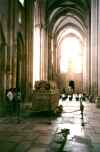|
|
|
Leiria is pleasantly situated at the confluence of two rivers, the Liz and the Lena, and at the foot of a hill crowned by a medieval castle. It is also near the beautiful beaches at Nazaré, the santuary at Fátima, and the magnificent architecture of Batalha and Alcobaça.
|
|
|
The Leiria region has kept alive its tradition of popular art and folklore. The well known crystal made by Atlantis is manufactured by hand nearby
|
|
|
Source, Michelin Tourist Guide
|
|
|
The church building in Leiria is a former residence located on the corner of a busy street. The home makes a wonderful chapel. The chapel area is very comfortable. The main floor also has a batismal font, a kitchen, and classrooms. The hard wood floors are beautiful and had been restored after the flood in 1998. Upstairs are more classrooms and offices. The downstairs houses the family history center. The garage has been converted into a cultural hall with a stage.
|

Click to enlarge |
|

Click |
One thing that new missionaries notice right away upon arriving in Portugal is how small the cars are. The West children were particularly intrigued by the motorized tricycles. Even more unusual were the number of people that could fit in these compact vehicles. We had to take a picture of this new vehicle we encountered near the castle in Leiria.
|
|
|
The castle at Leira has a beautiful palace that was added after the land was secure from the Moors. A promenent architectural feature of the palace is the royal balcony shown in this picture. The balcony affords a spactacular view of Leiria.
|

Click to enlarge |
|

Click to enlarge |
South and West of Leira is the cathedral of Batalha. With a small defensive army, João I of Avis, defeated a larger Spanish army, thus preventing Spanish domination of Portugal. Having made a vow to a build a superb church in honor of the Virgin Mary if he won the battle, the Cathedral of Batalha came into being. Construction started on this cathedral shortly after D. João won his decisive battle against the Spanish in 1385 AD. The structure if very ornate and inspiring. To one side is the Founder´s Chapel containing the tombs of Don João I, his queen, Philippa of Lancaser (English)and four of their children, including Prince Henry, the Navigator.
|
|
|
The last 600 year have taken their toll on the stone of Batalha. Modern craftsman carve new stones to replace the weathered ones. Structural stone as well as the wonderful statuary are being replaced This repair work is going on constantly, providing a living example of this craft we seldom see in the United States. It is amazing what the Portuguese can carve in stone.
|

Click to enlarge |
|

Click to enlarge |
The cathedral in Alcobaça had its beginnings as the result of a vow by Afonso Henriques, the first king of Portugal. In fulfillment of the vow if success in battle were achieved he founded this abbey. The first building was constructed in 1178 and later destroyed by the Moors. Reconstruction was completed in 1253. Located in the transept of the cathedral are the tombs of Inêz de Castro and Dom Pedro. Their tombs are positioned so that at resurrection they will rise to face each other. The story of Pedro and Inêz is a "Romeo and Juliet" story and widely memorialized in the literature of the day. Inêz was a lady in waiting to Pedro´s first queen who subsequently died. A more complete story of Inêz can be found in the cultural section of this web site.
|
|
|
South of Leiria is the castle at Porto de Mós. Few missionaries get a change to visit this castle since it is out of the way. It rests on rock outcropping rising above the fertile fields below. This picture indicates the thickness of castle walls. Because of the thichness of the walls, achitechural features such as these benches were built into the walls. Benjamin West demostrates a "J C Penney" pose.
|

Click to enlarge |
|

Click to enlarge |
Outside the city of Alcobaça is the factory were the Atlantis crystal is manufactured. All of their crystal is hand blown. Teams of 10 to 15 workers perform a carefully choreography of steps to create a single piece. Then the pieces move into the grinding and painting areas for finish work. The pieces are exquisite
|
|
|
The city of Nazaré lays on the coast, east and south of Leiria. This is a very popular beach and a very quaint fishing villiage. Like Figueira da Foz, the old style fishing boots are colorfully and distinctively painted. Notice the pattern work in the cobble stone road.
|

Click to enlarge |
|

